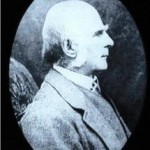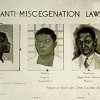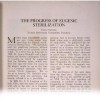The Continuum of Eugenics Practice
 Francis Galton, the English scientist who coined the term, defined eugenics as “the agencies under social control that improve or impair the racial qualities of future generations either physically or mentally.” Charles Davenport, the father of the American eugenics movement called it simply “the self direction of human evolution.”
Francis Galton, the English scientist who coined the term, defined eugenics as “the agencies under social control that improve or impair the racial qualities of future generations either physically or mentally.” Charles Davenport, the father of the American eugenics movement called it simply “the self direction of human evolution.”
These definitions stress differences that occupied either end of a continuum of eugenics practice. At one end, Galton’s definition stressed social control, or laws, to control human reproduction. At the other end, Charles Davenport’s stressed an individual’s own control over their reproduction. Social control ultimately embodied “negative eugenics”– limiting mixed race marriages, restricting immigration from southern and eastern Europe, and sterilizing mental and epileptic patients. Self-direction embodied “positive eugenics” – taking personal measures to improve one’s own genetic heritage through mate selection.
Of course, things weren’t that simple. Galton never strongly advocated for negative eugenics, and England never inacted coercive eugenics legislation. To the contrary, Davenport’s Eugenics Record Office successfully lobbied state governments and the U.S. congress to enact restrictive eugenics legislation that culminated in the U.S. Supreme Court upholding the premise of compulsory sterilization.
The Holocaust represented the nadir of eugenic practice, but it would be wrong to think eugenics ended with the Nazis. As examples, ethnic cleansings continue to this day in Darfur, and disincentives against large families trump personal reproductive wishes in China. At the same time, fertility drugs and in vitro fertilization extend reproduction to infertile couples, and pre-implantation DNA diagnosis puts the ultimate slant on the notion of self-directing of human evolution.
And somewhere in between is the simple act of picking the healthiest, most virile mate we can find to help us propel our genes into the future. We all lie somewhere on the continuum of eugenics practice.
| Print article | This entry was posted by David Micklos on October 22, 2009 at 10:25 am, and is filed under Eugenics Archive. Follow any responses to this post through RSS 2.0. You can skip to the end and leave a response. Pinging is currently not allowed. |










